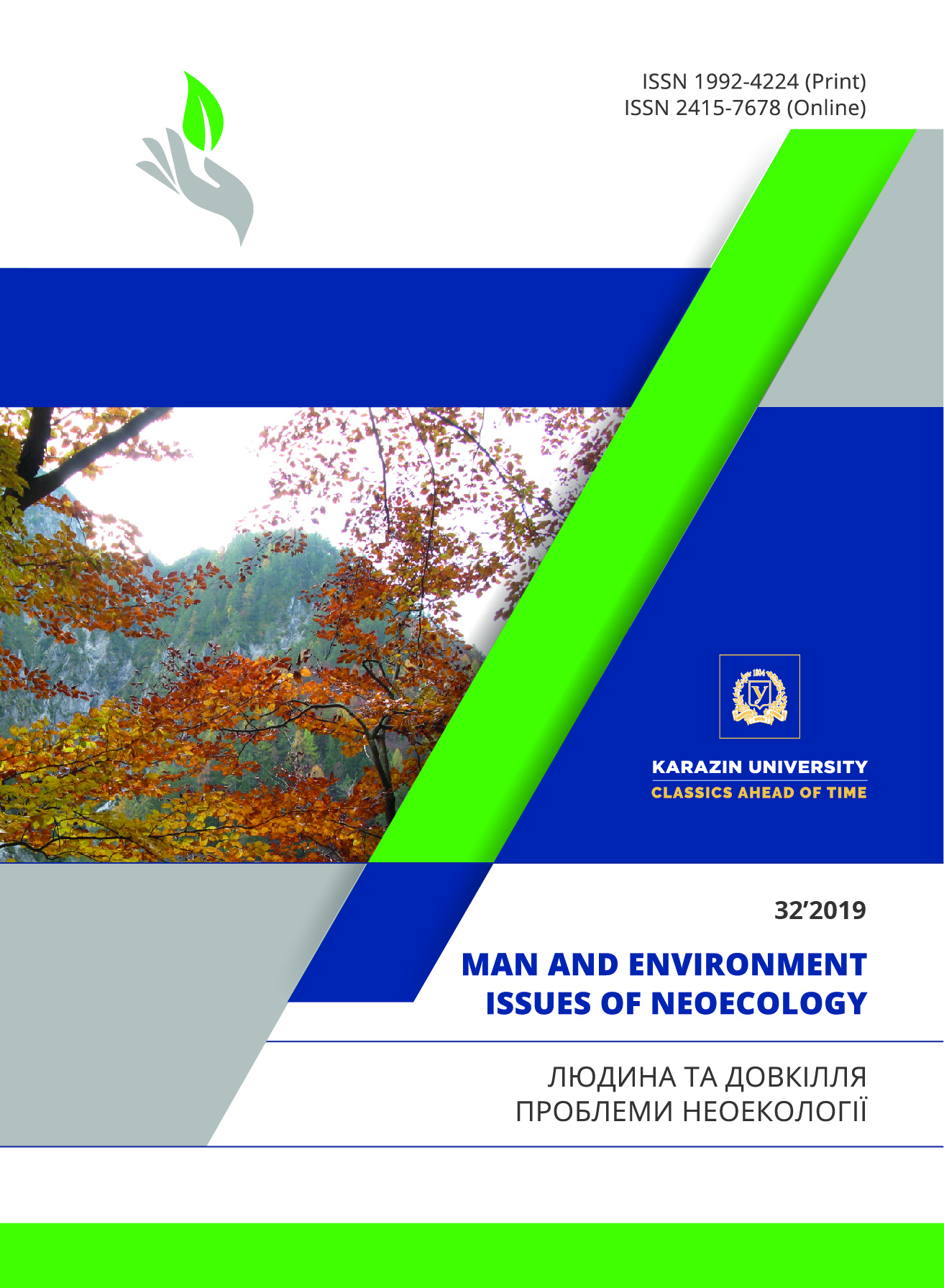Analysis of the Conflicts of Natural Use as a Basis For Landscape-Ecological Planning of Forest Ecosystems
Abstract
Relevance. The development of measures to prevent possible negative environmental, economic and social problems in forest ecosystems should be based on objective information, which may be provided by the process of landscape-environmental planning.
Purpose. Analysis of the conflicts of nature use from anthropogenic activity in forest ecosystems to develop measures optimization of environmental management in the process of landscape-ecological planning.
Methods. The assessment of conflicts of nature use in forest ecosystems was carried at the test site of the tract "Zarudska Dacha" of Lyubovytsi forestry of the Malinsky district of Zhytomyr region according to the author's method of landscape-ecological planning.
Results. Based on the results of the inventory and evaluation phase of landscape-ecological planning, we have obtained information about the landscape differentiation of the test area, internal and external sources of environmental conflicts, their boundaries, and intensity. The study of the structure of forestry has shown that the sources of conflict are predominantly forest areas and settlements landscapes. The assessment of intensity of the conflicts has shown that medium-intensity conflicts prevail in the territory. Based on the information of matrices of the conflict measures to optimize the use of nature in forest ecosystems have been developed.
Conclusions. For optimization of nature use in forest ecosystems, it is recommended: restoration of plantations, control of rational use of forest resources, reduction of the volumes of use of the chemical means on the adjacent fields, organized garbage collection, controlled recreation, etc.
Downloads
References
Albert, С., Aronson, J., Fürst, C., & Opdam, P. (2014). Integrating ecosystem services in landscape planning: requirements, approaches, and impacts. Landscape Ecology, 29(8), 1277–1285.
De Groot, R. S., Alkemade, R., Braat, L., Hein, L., & Willemen, L. (2010). Challenges in integrating the con-cept of ecosystem services and values in landscape planning, management and decision making. Ecological Complexity, 7(3), 260-272.
V. Haaren, C., Galler, C., & Ott, S. (2008). Landscape planning. The basis of sustainable landscape devel-opment. Leipzig: Gebr. Klingenberg Buchkunst Leipzig GmbH.
Rudenko, L., & Maruniak, Ye. (2012). Landscape planning and it’s importance for sustainable spatial devel-opment of Ukraine. Ukrainian Geographical Journal, (1), 3-8 (In Ukrainian).
Maksymenko, N. V. (2017). Landscape and environmental planning: theory and practice: monograph. Kharkiv : KKhNU, 216. (In Ukranian).
Maksymenko, N. V. (2016). Landscape and environmental planning as the basis for administrative deci-sionmaking on ecosystem services. Visnyk V.N. Karazin KNU series of "Geology. Geography. Ecology”, (45), 153-158. (In Ukrainian).
Maksymenko, N. V., Klieshch, A. A. (2017). Directions for optimization of natural resource use in environmental management for local areas. Journal оf Geology Geography аnd Geoecology , 25 (2). 81-88. DOI https://doi.org/10.15421/111722 (In Ukranian).
Maksymenko, N. (2012). Landscape planning as a method of territory’s ecological acсomplishment. Problems of Continuous Geographical Education and Cartography, 2012 (16), 65-68. (In Ukrainian).
Maksymenko, N., Kvartenko, R. (2013). Spatial planning of the ecological network of Kharkiv region on land-scape basis. Scientific statements of the Belgorod state university. Series: natural sciences, 2013 (7(160), 178-186. (In Russian).
Maksymenko N. V., Voronin V. O., Cherkashyna N. I., Son’ko S. P. (2018).Geochemical aspect of landscape planning in forestry. Journal of Geology, Geography and Geoecology. 27 (1), 81-87. Available at: https://geology-dnu.dp.ua/index.php/GG/article/view/498/451
Maksymenko, N., Klieshch, A., Mykhailova, K., & Gohol, O. (2015). Features of landscape-ecological plan-ning of territories of different functional purposes. Geography, ecology, tourism: theory, methodology, prac-tice : International Scientific and Practical Conference. Ternopil: SMP «Taip», 249-251 (in Ukrainian).
Maksymenko N. V., Voronin V. O. (2016). Evaluation of Spatial Background Radiation in Landscape of Vasitschivsky Forest. Biodiversity after the Chernobyl Accident, International network AgroBioNet. Part II. Slovak University of Agriculture in Nitra, 157-161. (In Ukranian).
Maksymenko N. V., Dobronos A. M., Voronin V. O. (2015). Spatial and temporal changes landscapes Va-sishchevskogo forestry and connected areas. Man and environment. Issues of neoecology, (1-2), 55-62. (in Ukranian).
Maksymenko, N.V., Koresheva, O.V. (2014). Analysis of the nature management conflicts as a basis for landscape planning of Homilshansky forest area. Vіsn. Lvіvsk, Ser. Geogr. (48), 261-267 (In Ukranian).
Regional report on the state of the environment of the Zhytomyr region in 2016. Available at: https://menr.gov.ua/files/docs/Reg.report/Доповідь%20Житомирська%20%202016.pdf
Declaration on compliance with the requirements of FSC "Malinsky LH" principles and criteria of FSC (2019). Available at: https://malynlis.com.ua/informacija/sertifikacija.html
Report to the public on monitoring of economic activity and especially valuable for the conservation of forests (OCZL) of SE "Malinsky Forestry APK" (2018).) Available at: http://www.malinapk.net/images/docs/zvit2018.pdf.
Environmental Impact Assessment (EIA) of the planned economic activity of SE "Malyn Forestry" for 2018. (2018). Available at: https://malynlis.com.ua/informacija/sertifikacija.html.
The plan of afforestation of the State enterprise "Malinsky Forestry" Lyubovytsky forestry. (2008). Available at: http://www.lisproekt.gov.ua/wp-content/uploads/2018/01/02_Lyubovitske.jpg
Rudenko, L., Lisovskyi, S., & Maruniak, Ye. (2016). Environmental guideline in priorities of integral planning pro-cess in Ukraine. Ukrainian Geographical Journal, (2), 3-12. (In Ukrainian).
Authors reserve the right of attribution for the submitted manuscript, while transferring to the Journal the right to publish the article under the Creative Commons Attribution License 4.0 International (CC BY 4.0). This license allows free distribution of the published work under the condition of proper attribution of the original authors and the initial publication source (i.e. the Journal)
Authors have the right to enter into separate agreements for additional non-exclusive distribution of the work in the form it was published in the Journal (such as publishing the article on the institutional website or as a part of a monograph), provided the original publication in this Journal is properly referenced
The Journal allows and encourages online publication of the manuscripts (such as on personal web pages), even when such a manuscript is still under editorial consideration, since it allows for a productive scientific discussion and better citation dynamics (see The Effect of Open Access).





